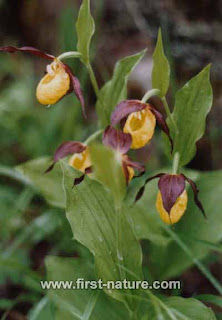We have just returned from a visit to Ireland where, for once, the weather was actually better than in the UK during the same period. For those of you who think that there cannot be much to choose between the weather in UK and Ireland at ANY time of the year, the fact is that if it is wet in England it's usually even wetter in Ireland. Our first port of call was The Burren right out in the west in Co Clare. We usually visit in June to get the best of the orchids and I was somewhat doubtful of finding any in bloom so late in the season. In fact, we found four species flowering, two of which were actually in peak condition.
We found the first species, Autumn Lady's-tresses - Spiranthes spiralis, in the dune slacks at Fanore which is right out on the coast close to Black Head. This is the last of the species to flower in the UK and can occur from the end of July right through into the beginning of Spetember. They are a dainty delight and so small that they can be extremely difficult to spot. We found several singletons and one or two little groups of up to four plants in each. This orchid is well-known from this location but nowhere there are they as common as they are in other parts of Europe.
The Burren is a rocky landscape that, from a distance looks totally devoid of any kind of vegetation let alone orchids. Only when you get into The Burren itself can you see that it is made up from limestone pavement which is composed of flat areas (clints) with (sometimes as deep as 2 metres) crevices in between (grykes). It is in these crevices, which retain moisture from rainfall, that the plants flourish. Around 25 orchid species occur in this small area (approximately 250 square kilometres) along with many other common and rare wildflowers. In fact there are more wildflowers in this part of Co Clare than there are in any other county in Ireland. Because of this, The Burren is a protected landscape; part of it is a National Park and it is protected by EU conservation directives.
Apart from the amazing number of plants to be found in The Burren, there is another factor that makes its plantlife very special and unusal and that is the occurence of both Mediterranean and Arctic species that occupy the same spaces and flower at the same time. For instance, the Arctic plant Mountain Avens - Dryas octopetala - grows alongside Dense-flowered Orchid (sometimes called The Irish Orchid) - Orchis intacta - a predominantly Mediterranean species.I digress! The other orchid species that we found during our brief visit were Fragrant Orchid - Gymnadenia conopsea - again in the dune slacks at Fanore and in perfect condition, Broad-leaved Helleborine - Epipactis helleborine - almost over but with one or two reasonable flowers at the top of the flower-spikes, and last but not least, a delightful white Common Spotted-orchid - Dactylorhiza fuchsii. The latter was flowering alone and therefore unlikely to be the subspecies Dactylorhiza okellyi which is one of the real specialities of The Burren.
Regrettably we were too late to find Dark-red Helleborines - Epipactis atrorubens - although I think I spotted some gone-over specimens high up in the rocky crevices above Ballyvaughan. It means I shall have to go back again to find them in better shape - soon! Next year, I hope.



